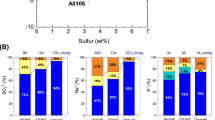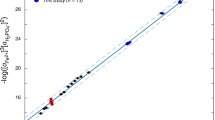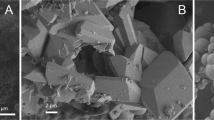Abstract
BECAUSE of the widespread occurrence of carbonates in marine sediments there has been a continuing interest in the mineralogy of carbonate phases that can be chemically precipitated from seawater1–9. The discovery of metastable carbonate minerals (aragonite and high-magnesium calcites) of non-skeletal origin occurring as cementing material in submarine sedimentary environments10–12 has further stimulated interest in mechanisms that might explain these occurrences. Aragonites have been formed from seawater in a variety of experiments approximating natural conditions7,8,13. Attempts at the synthesis of high-magnesium calcites in such conditions have met with little success. We only know of three published papers in which high-magnesium calcites have been precipitated from seawater2,5,9,. In only one of these was supporting X-ray diffraction evidence presented to document the mineralogy and in all cases the phases were produced by the addition of Na2CO3 or NaHCO3.
This is a preview of subscription content, access via your institution
Access options
Similar content being viewed by others
References
Vetter, F., Zeit. Kryst. Min., 48, 45 (1910).
Lucas, G., Compt. Rend., 226, 937 (1948).
Lucas, G., Compt. Rend., 226, 1023 (1948).
Lucas, G., Compt. Rend., 227, 1026 (1949).
Baron, G., and Pesneau, M., Compt. Rend., 243, 1217 (1956).
Kitano, Y., and Hood, D. W., J. Oceanogr. Soc. Japan, 18, 141 (1962).
Simkiss, K., Nature, 201, 492 (1964).
Groot, K. de, Nature, 207, 404 (1965).
Glover, E. D., and Sippel, R. F., Geochim. Cosmochim. Acta, 31, 603 (1967).
Fischer, A. G., and Garrison, R. E., J. Geol., 75, 488 (1967).
Ginsburg, R. N., Shinn, E. A., and Schroeder, J. H., Abst. Ann. Meet. Geol. Soc. Amer., 78 (1967).
Milliman, J., Science, 153, 994 (1966).
Cloud, P. E., US Geol. Surv. Prof. Pap., 350, 76 (1962).
Gruzensky, P. M., in Crystal Growth, suppl. to J. Phys. Chem. Solids, 365 (1967).
Kaspar, J., Rost Kristallov, 2, 58 (Engl. Transl. Consultants Bur. Inc., New York, 1959).
Goldsmith, J. R., Graf, D. L., and Joensuu, O. I., Geochim. Cosmochim Acta, 7, 212 (1955).
Mellor, J. W., A Comprehensive Treatise on Inorganic and Theoretical Chemistry, 4 (Longmans, Green and Co., London, 1923).
Author information
Authors and Affiliations
Rights and permissions
About this article
Cite this article
TOWE, K., MALONE, P. Precipitation of Metastable Carbonate Phases from Seawater. Nature 226, 348–349 (1970). https://doi.org/10.1038/226348a0
Received:
Revised:
Issue Date:
DOI: https://doi.org/10.1038/226348a0
This article is cited by
-
Geochemical study of lime-mud borings and associated coral-reef limestones in the intertidal flat of Kondoi Beach, Taketomi Island, Okinawa, Japan
Carbonates and Evaporites (2002)
-
Skeletal development inAcropora cervicornis
Coral Reefs (1983)
Comments
By submitting a comment you agree to abide by our Terms and Community Guidelines. If you find something abusive or that does not comply with our terms or guidelines please flag it as inappropriate.



